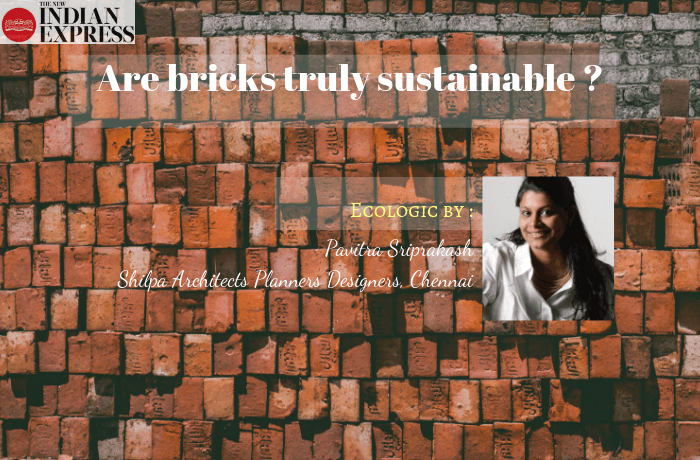29-May-2019: Pavitra Sriprakash, Director and Chief Designer at Shilpa Architects Planners Designers writes a weekly column on Sustainability for The New Indian Express titled “ECOLOGIC”. This week she writes about using bricks for construction and whether it is a sustainable construction material.
Full article below: (Also available at The New Indian Express Website)
Are bricks truly sustainable ?
A recent question posed by a client was — is a brick building more sustainable? While this may seem a simple enough question, the answers are really not as straight forward. It is true, the first thing that occurs in the minds of most people is that brick is natural and therefore must be more earth-friendly.
The foremost criteria for evaluating the sustainability of a wall or building envelope material is the thermal insulation. This is measured by the unit R value — which is a measure of how well a two-dimensional barrier, such as a layer of insulation, a window or a complete wall or ceiling, resists the conductive flow of heat. According to Inspectapedia, basic brick walls have an insulation value, or R-value, of 0.2 per square inch. Conventional 8 inch concrete block walls have an R-value of 0.08 per square inch. In general, the greater the R-value, the greater the resistance, and so better is the thermal insulating properties of the barrier. Therefore, this far, the brick is faring as a better performer.
However, adding a layer of insulation or an air gap greatly changes the performance of brick and concrete. It is common in today’s marketplace to have aerated concrete blocks or insulated concrete blocks that are readily available. Insulated concrete blocks can increase their R-value to about 1.2 per square inch, and aerated blocks can have R-values as high as 3.9.
Bricks on the other hand suffer since very few value adds are made to them to have new products which are easily sourced in our material markets. It boils down to know-how and masonry techniques. Using techniques such as the architects favourite ‘rat trap bond’ can improve the thermal insulation. So, what are these ‘bonds’ and what specifically is a rat trap bond?
However, no performance data exists on the R-value of a rat trap bond brick wall — this is an assembly not a product and therefore becomes a bit trickier to ascertain. But despite the lack of data, one can make the following assumptions with some surety — an aerated concrete block wall is a better performer than a standard brick bond wall and a rat trap bond brick wall is better than any type of concrete wall!
So, the next time you are choosing to build, start with the fundamentals — brick may not always be the most sustainable, it has to have a right bond to give a great performance.



